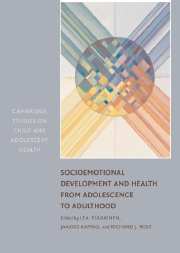Book contents
- Frontmatter
- Contents
- List of Contributors
- Preface
- Introduction
- PART I LONGITUDINAL AND BEHAVIORAL GENETIC APPROACHES
- PART II ADOLESCENT HEALTH-RELATED BEHAVIOR AND ADULT HEALTH
- PART III SOCIOEMOTIONAL BEHAVIOR IN EARLY ADOLESCENCE
- PART IV LIFE COURSE AND HEALTH
- 13 Identity Formation, Personal Control Over Development, and Well-Being
- 14 Sense of Coherence and Optimism: A More Positive Approach to Health
- 15 Unemployment and Psychological Distress, and Education as a Resource Factor for Employment
- 16 Personality, Work Career, and Health
- Summary and Future Directions
- References
- Author Index
- Subject Index
15 - Unemployment and Psychological Distress, and Education as a Resource Factor for Employment
Published online by Cambridge University Press: 07 December 2009
- Frontmatter
- Contents
- List of Contributors
- Preface
- Introduction
- PART I LONGITUDINAL AND BEHAVIORAL GENETIC APPROACHES
- PART II ADOLESCENT HEALTH-RELATED BEHAVIOR AND ADULT HEALTH
- PART III SOCIOEMOTIONAL BEHAVIOR IN EARLY ADOLESCENCE
- PART IV LIFE COURSE AND HEALTH
- 13 Identity Formation, Personal Control Over Development, and Well-Being
- 14 Sense of Coherence and Optimism: A More Positive Approach to Health
- 15 Unemployment and Psychological Distress, and Education as a Resource Factor for Employment
- 16 Personality, Work Career, and Health
- Summary and Future Directions
- References
- Author Index
- Subject Index
Summary
INTRODUCTION
Establishing a stable position in the work domain is one of the most important developmental tasks of adulthood (Havighurst, 1982; Levinson, Darrow, Klein, Levinson, & McKee, 1978; Levinson, 1996). Unsuccessful resolutions of this task, such as experiences of unemployment, have been linked to several indicators of low psychological, social, and physical functioning. In the area of psychology, the main interest has been in the identified link between unemployment and psychological distress.
In this chapter, two different hypotheses for this observed link between unemployment and distress are discussed: (a) social causation and (b) individual drift. Social causation means that unemployment is an agent that causes an increased level of psychological symptoms; individual drift implies that prior psychological problems make some individuals vulnerable to subsequent difficulties in the labor market. Findings based on the Jyväskylä Longitudinal Study of Personality and Social Development (JYLS) pertaining to these two hypotheses are also presented. Furthermore, this chapter investigates the early roots of later long-term unemployment and the mechanisms operating between child behavior and later difficulties in the labor market.
Because a lack of further education after comprehensive schooling increases the risk of unemployment, a part of the investigation reported here concerns whether an educational degree obtained at a later age (from a vocational school, a vocational college, or a university) buffers against further bouts of unemployment.
- Type
- Chapter
- Information
- Publisher: Cambridge University PressPrint publication year: 2006
- 3
- Cited by



